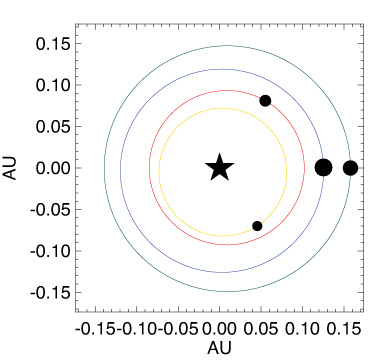Like snowflakes, no two planetary systems are the same. Astronomers have now observed one of the most unique planetary arrangements ever seen: four miniature Neptunes locked in perfect synch with each other — and it’s been like this for billions of years.
The Kepler-223 system looks similar to the HD 69830 system (pictured here), but with a fourth mini-Neptune, and likely no inner asteroid belt (Image: ESO)
Astronomers discovered the Kepler-223 star system several years ago using the Kepler Space Telescope, at which time they catalogued four Neptune-like planets spinning close to their star. And by close they mean it; all four of these gaseous planets are orbiting at a distance closer than Mercury is to our sun.
But that’s not even the most interesting part. Researchers from UC Berkeley and the University of Chicago have now learned that this quartet of miniature Neptunes is locked in an orbital dance that’s never been seen before.
Here’s how this particular planetary resonance works: Each time the innermost planet orbits eight times, the next planet down the chain orbits exactly six times, followed by orbits of four and three respectively. More simply, these synchronised orbital periods can be expressed as the ratio 8:6:4:3. Put another way, Kepler-223’s two innermost planets are in a 4:3 resonance, the second and third are in a 3:2 resonance, and the third and fourth are in a 4:3 resonance. Astronomers have observed extrasolar systems containing two or three planets in resonance but never four.
“This is the most extreme example of this phenomenon,” noted study co-author Daniel Fabrycky from the University of Chicago in a release.
Cool, right? And it’s been this way for billions of years, which is just as strange. Usually, these delicate arrangements are jostled out of place by the gravitational pull of neighbouring celestial objects, such as other planets and large asteroids. Extreme tidal forces can do the same.
Over the course of millions of years, the orbits have turned from elliptical to circular, and then back again. The resonance ratio may not change, but the planets’ gravitational effect on each other most certainly does. A simulation provided by the researchers (shown in the above video), chronicles millions of years of this orbital evolution. This planetary resonance can even be expressed in musical form:
Resonant orbits aren’t uncommon. In fact, Neptune and Pluto are caught in a 3:2 resonance. Each time Neptune orbits three times, Pluto completes its orbit of the sun twice. But four planets caught in this cosmic dance? That’s almost unheard of.
Almost. Astronomers theorise that our solar system once featured a four-planet resonance between the four gas giants, Jupiter, Saturn, Neptune, and Uranus. But at some point in their 4.5-billion-year history, these planets got knocked out of their elegant arrangement.
Kepler-223 is helping astronomers understand how our solar system and other star systems formed. It could even solve the question of whether planets stay in the same place where they formed, or whether they migrate inwards or outwards from their host star over time.

“Basically, this system is so peculiar in the way that it’s locked into resonances that it strongly suggests that migration is the method by which the planets formed — that is, migrating inward toward the star after forming farther out,” noted study co-author Howard Isaacson in a Berkeley release.
In the case of Kepler-223, these planets could have assumed their resonant positions around their star within a few 100,000 to 200,000 years. Soon after forming, two of the planets began to migrate toward the star, but then got stuck together, and then continued their inward migration together. Then they locked onto a third planet, and so on until all four planets were synchronised and locked into stable stellar orbits.
But the astronomers suspect that there are other circumstances that permitted the resonance to persist for six million years, namely the absence of other celestial bodies.
“These resonances are extremely fragile,” noted Fabrycky. “If bodies were flying around and hitting each other, then they would have dislodged the planets from the resonance.” Kepler-223’s planets, it would appear, somehow managed to dodge this scattering of cosmic bodies.
[Nature]
